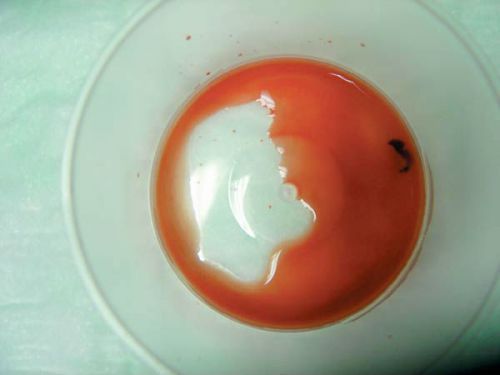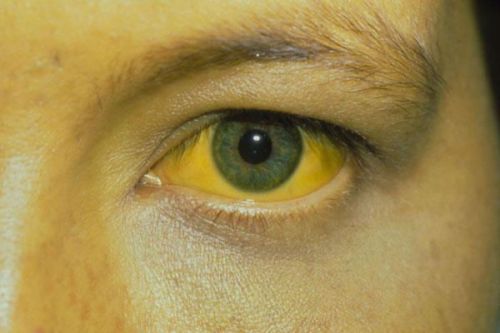The phenomenon of the appearance in the urine visible to the naked eye the blood, called hematuria. In a healthy person it is very rare, most often the urinary excretion of red blood cells (RBCs) is one of the most common symptoms of urological pathology.
Often hematuria may never happen again, dulling the vigilance of medical specialists and the patient. However, the presence of traces of blood in the urine is often terrible symptom and correct his study in many cases decides the fate of the patient.
In men, this symptom can be cause for excitement, often with quite good reason. Let’s see – why in the urine men blood appears what causes this phenomenon and what to do in such cases?
What is the urine?
Urine (in Latin “urina”) is a form of excrement (the waste products) that produce and secrete the kidney. This biological fluid has its own properties and characteristics, changes of which indicate development in the human body pathological processes. Clinical examination of the urine plays an important role in the diagnosis of various diseases of the urinary and reproductive systems.

Normal rates in laboratory analysis are the following:
- the amount allocated during the day urine is 1.5-2 liters;
- color – straw yellow, transparent;
- smell – mild;
- the relative specific gravity from 1010 to 1025;
- the rate of acid-alkaline balance (pH) from 4.5 to 7.5;
- squamous epithelial cells – isolated in a field of view;
- protein, glucose, crystals salts, yeast fungus, cylinders, bacteria do not exist;
- white blood cells – men have no more than 1-2 in p/SP., women have 6-8 in p/Zr.;
- mucus – a small amount;
- red blood cells – women have no more than 1-2 in p/SP., men do not exist.
In some cases in the urine in men appear red blood cells?
The appearance of urine with blood from the men – a sign of serious pathological processes in the upper urinary tract (kidneys and ureters) and lower urinary tract (urethra, bladder) requiring urgent medical care.
Practicing urologists are distinguished:
- the microhematuria – blood cells can be detected only by microscopic examination of the urinary sediment;
- gross hematuria – the presence in the urine of erythrocytes is detected by visual inspection, the urine is of red color or tinge of “meat slops”.
In the elderly hematuria indicates more severe disease than young men, not suffering from chronic ailments.

Causes of urine blood are different, most often this symptom means the development of renal disease:
- acute or chronic glomerulonephritis;
- urolithiasis;
- polycystic;
- malignant tumors;
- heart attacks the kidneys;
- chronic renal failure;
- internal bleeding resulting in kidney injury;
- obliterating thromboangiitis (disease Winiwarter-Burger).
Often bloody urine during acute bladder inflammation, urinary schistosomiasis (a parasitic infection caused by Bioelements), nephrotoxicity tuberculosis
If urination is accompanied by pain and blood comes out at the beginning of the process, the cause of this phenomenon can serve as a foreign body, constriction of the urinary canal, the development in it of the tumor.
Other risk factors that increase the probability of selection into the urine red blood cells
In some cases urination with blood in men is a common symptom of pathologic process, this can be a temporary phenomenon as a result of:
- excessive exercise is caused by acceleration of the filtering function of the kidneys as a result of intensive work of all systems of the human body (blood admixtures in the urine has completely disappeared, you need to fully relax);
- visiting the baths or saunas – is associated with increased blood pressure;
- injuries of the urethra after the medical procedures – taking a swab or scraping from the urethra, the introduction into the urethra of a catheter;
- physiological erection or sexual intercourse;
- of certain medications – Heparin Fenilina, Rifampicin.
The appearance of blood from the urethra after urine excretion is observed in such diseases of the circulatory system, like anemia, leukemia, hemophilia.
One of the most common etiological factors of hematuria is inflammation of the genitourinary system, accompanied by poor circulation in the place of localization of pathological process.
Blood in the urine inflammation of the bladder
Acute cystitis affects the mucous cover of the body.
Most often the disease has an infectious etiology, there are the following main causes of development of inflammatory process:
- infection with pathogenic bacteria – Escherichia coli, Klebsiella, cocci;
- violation of the nervous regulation of the bladder;
- injuries after catheterization or cystoscopy;
- inflammation of the testicles – orchitis;
- exposure to toxic substances;
- inflammation of the prostate gland – prostatitis.
The development of the inflammatory process predisposes the hypothermia, decreased immunity, failure to comply with elementary rules of hygiene, unprotected sexual intercourse.
The disease manifests itself:
- frequent urge to urine excretion;
- pain when urinating;
- change transparency and tint of the urine.

Often the urine has a bright red color – this means that there is a significant amount of red blood cells. The contents in the urine of more than 50 red cells in field of view is typical for hemorrhagic cystitis, which is considered a serious disease that occur with clouding of the urinary sediment, increased mucus, increased number of leukocytes and cells of the squamous epithelium.
Very dangerous pathological condition where in the urine in men appear blood clots, and the body temperature rises above 38°C. these symptoms indicate a malignant tumor in the bladder, which grows in neighboring tissues and organs, destroying blood vessels
There are three types of bladder cancer, each of them bears the name of those cells from which it evolved.
Features of hematuria in glomerulonephritis
There are two types of inflammation of the glomeruli (the glomeruli) or glomerular nephritis:
- Primary – independent autoimmune diseases.
- Secondary or system – develops as a result of other diseases: endocarditis; rheumatic fever; hemorrhagic vasculitis; periarteritis nodosa; lupus erythematosus.
The pathological process develops as a result of immune response to foreign antigen when deposited in the glomeruli of immune complexes of antibodies. This phenomenon hampers blood circulation and causes the development of renal failure.
Most often, acute glomerular nephritis develops in people over 40 years of age and is characterized by the following types of syndromes:
- urinary – reduced daily urine output, while microscopic examination detected protein, red blood cells, hyaline and granular casts;
- edematous – characterized by pallor, swelling, and friability of the tissues of the face, the “hidden” edema of the lower extremities, to identify only with daily weighing of the patient, measuring urine output or waste samples by MC Clure-Aldrich syndrome (patient into the skin is injected with a small amount of liquid and watching the speed of its resorption);
- hypertensive – increase blood pressure up to high levels (185-115 mm of mercury. calendar), which causes pain in the head and the heart arrhythmia, with a favorable course of the pathological process, the phenomenon is transient, the AP values are normalized within 10-14 days.
Chronic glomerulonephritis occurs without manifestation of characteristic clinical symptoms, the pathological condition is detected only in the laboratory study of urine – the presence of blood is a constant symptom of the disease.
Modern methods of diagnosis of hematuria and effective treatment of diseases

If a man when urinating the urine has blood, it is necessary to urgently seek the advice of a qualified urologist, who will conduct the examination, will put the exact diagnosis and prescribe a rational treatment.
One of the main methods of identifying nephrotic disease is a symptom pasternatskogo in which, after tapping the lower back area of the kidneys is urine, the patient will go fresh erythrocytes
Integrated diagnostic examination of the patient consists of:
- physical examination;
- clinical studies of urine and blood;
- specific urine samples – General and Nechiporenko;
- biochemical analysis of blood;
- the study of feces to detect in the stool the presence of parasites;
- Ultrasound of the urinary organs;
- x – ray study urography;
- research vessels – angiography.
Every man is important to remember that the repeated appearance of blood in the urine is cause for seeking medical help
Methods specific treatment of hematuria depends on the primary pathological process, they can be conservative or surgical, for example:
- acute inflammation of the bladder requires the use of antibiotics, painkillers, copious drinking;
- to infections of the prostate also prescribe antibiotic and antimicrobial agents;
- the presence of stones in the urinary tract requires surgery, otherwise the stones can block the urinary ways and can cause serious complications, even death.
Summarizing all the above, I want to note once again that the presence of blood in urine in men is a serious abnormality that can lead to irreversible for the body effects! That is why the detection of this feature requires a thorough examination and the required therapy.



